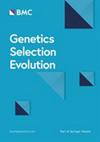基于序列的GWAS在18万头德国荷斯坦牛中揭示了新的候选产奶性状变异
IF 3.1
1区 农林科学
Q1 AGRICULTURE, DAIRY & ANIMAL SCIENCE
引用次数: 0
摘要
产奶量性状复杂,受多种遗传和环境因素的影响。尽管已经对这些性状进行了广泛的研究,迄今为止揭示了许多关联,但由于它们的关键经济重要性,复杂的遗传结构,以及牛的因果变异仍然很少的事实,有必要更好地了解它们的遗传背景。在这项研究中,我们的目的是在德国荷斯坦牛(德国和世界上最重要的奶牛品种)中找到与产奶量性状相关的新的候选位点。为此,在序列水平上对180217头牛进行了估算,并进行了大规模全基因组关联研究(GWAS),随后进行了精细定位、进化和功能注释,以识别和优先考虑新的关联信号。使用大型牛数据集的输入序列数据,我们确定了50,876个重要变异,确认了许多已知的和鉴定了以前未报道的牛奶(MY),脂肪(FY)和蛋白质产量(PY)的候选变异。使用贝叶斯方法对全基因组的重要信号进行精细映射,该方法确定可信的变体集,并生成每个信号的因果关系概率。使用关于函数和进化的外部信息进一步分类具有最高因果概率的变量,使后续验证实验的优先级更容易。与随机变异相比,精细作图确定的顶级潜在因果变异解释了很大比例的遗传变异;178个变量解释了11.5%,104个解释了7.7%,68个变量分别解释了MY、FY和PY的3.9%,表明了因果关系的可能性。我们的发现证明了大样本和基于序列的GWAS在检测新的关联信号方面的能力。为了充分利用GWAS的力量,应该将目标放在结合全基因组序列数据的非常大的样本上。正如我们的研究所展示的那样,这些也会带来计算和时间上的负担。尽管对牛的产奶性状进行了全面的研究,但这些性状的遗传背景仍未完全了解,许多新的关联可能被揭示,如下所示。随着样本量的不断增长,我们期望在未来对牛奶生产性状的遗传结构有更多的了解。本文章由计算机程序翻译,如有差异,请以英文原文为准。
Sequence-based GWAS in 180,000 German Holstein cattle reveals new candidate variants for milk production traits
Milk production traits are complex and influenced by many genetic and environmental factors. Although extensive research has been performed for these traits, with many associations unveiled thus far, due to their crucial economic importance, complex genetic architecture, and the fact that causal variants in cattle are still scarce, there is a need for a better understanding of their genetic background. In this study, we aimed to identify new candidate loci associated with milk production traits in German Holstein cattle, the most important dairy breed in Germany and worldwide. For that purpose, 180,217 cattle were imputed to the sequence level and large-scale genome-wide association study (GWAS) followed by fine-mapping and evolutionary and functional annotation were carried out to identify and prioritize new association signals. Using the imputed sequence data of a large cattle dataset, we identified 50,876 significant variants, confirming many known and identifying previously unreported candidate variants for milk (MY), fat (FY), and protein yield (PY). Genome-wide significant signals were fine-mapped with the Bayesian approach that determines the credible variant sets and generates the probability of causality for each signal. The variants with the highest probabilities of being causal were further classified using external information about the function and evolution, making the prioritization for subsequent validation experiments easier. The top potential causal variants determined with fine-mapping explained a large percentage of genetic variance compared to random ones; 178 variants explained 11.5%, 104 explained 7.7%, and 68 variants explained 3.9% of the variance for MY, FY, and PY, respectively, demonstrating the potential for causality. Our findings proved the power of large samples and sequence-based GWAS in detecting new association signals. In order to fully exploit the power of GWAS, one should aim at very large samples combined with whole-genome sequence data. These can also come with both computational and time burdens, as presented in our study. Although milk production traits in cattle are comprehensively investigated, the genetic background of these traits is still not fully understood, with the potential for many new associations to be revealed, as shown. With constantly growing sample sizes, we expect more insights into the genetic architecture of milk production traits in the future.
求助全文
通过发布文献求助,成功后即可免费获取论文全文。
去求助
来源期刊

Genetics Selection Evolution
生物-奶制品与动物科学
CiteScore
6.50
自引率
9.80%
发文量
74
审稿时长
1 months
期刊介绍:
Genetics Selection Evolution invites basic, applied and methodological content that will aid the current understanding and the utilization of genetic variability in domestic animal species. Although the focus is on domestic animal species, research on other species is invited if it contributes to the understanding of the use of genetic variability in domestic animals. Genetics Selection Evolution publishes results from all levels of study, from the gene to the quantitative trait, from the individual to the population, the breed or the species. Contributions concerning both the biological approach, from molecular genetics to quantitative genetics, as well as the mathematical approach, from population genetics to statistics, are welcome. Specific areas of interest include but are not limited to: gene and QTL identification, mapping and characterization, analysis of new phenotypes, high-throughput SNP data analysis, functional genomics, cytogenetics, genetic diversity of populations and breeds, genetic evaluation, applied and experimental selection, genomic selection, selection efficiency, and statistical methodology for the genetic analysis of phenotypes with quantitative and mixed inheritance.
 求助内容:
求助内容: 应助结果提醒方式:
应助结果提醒方式:


